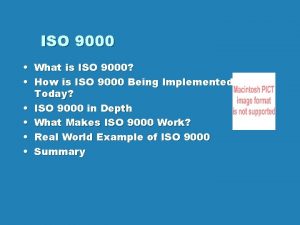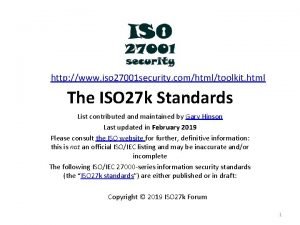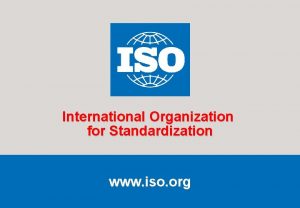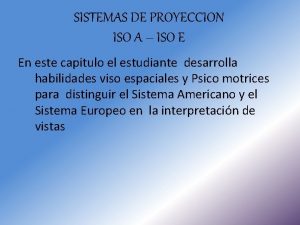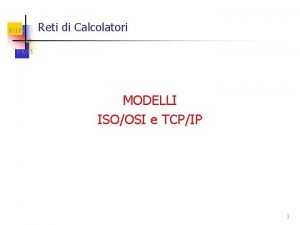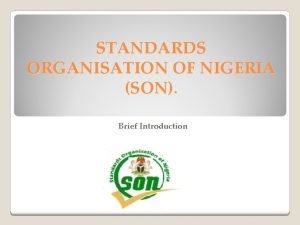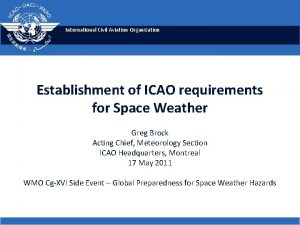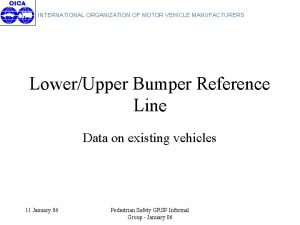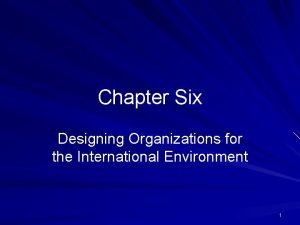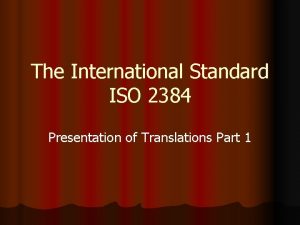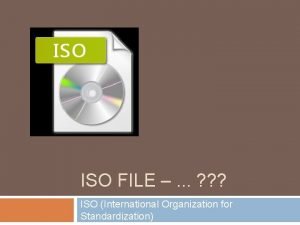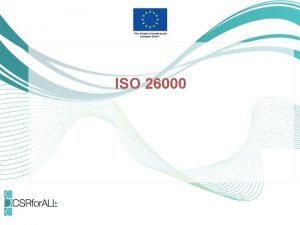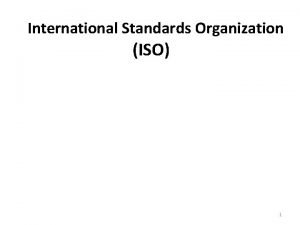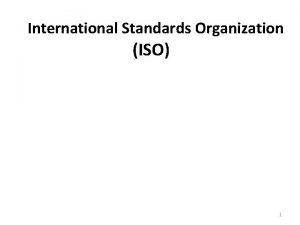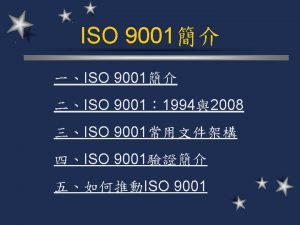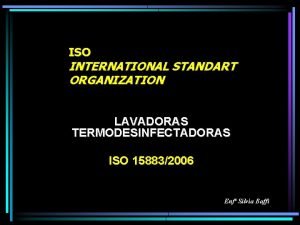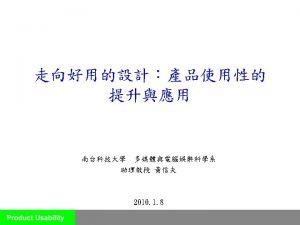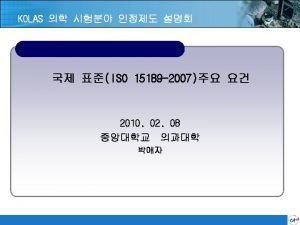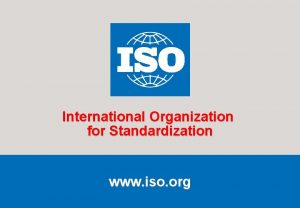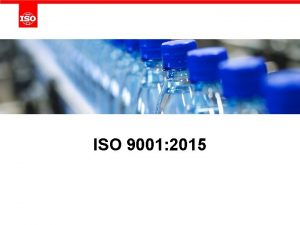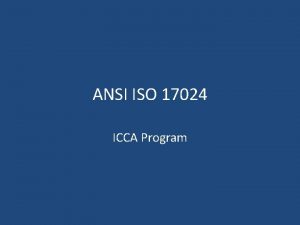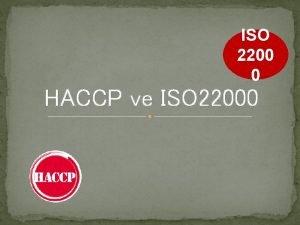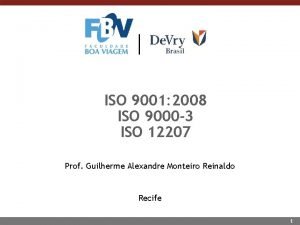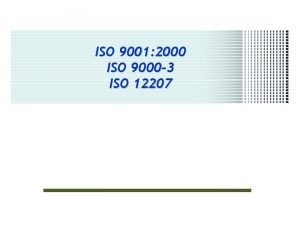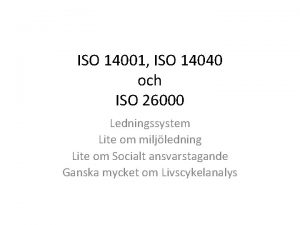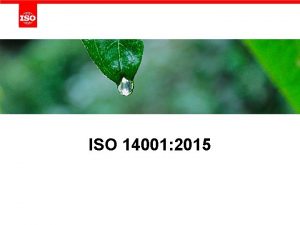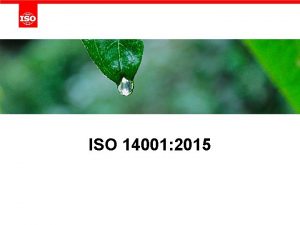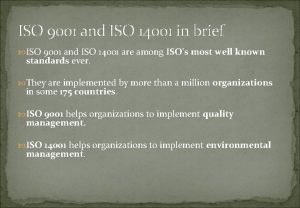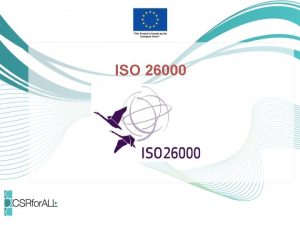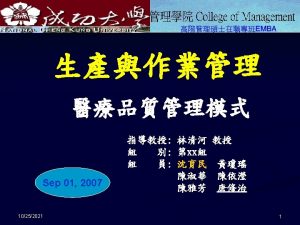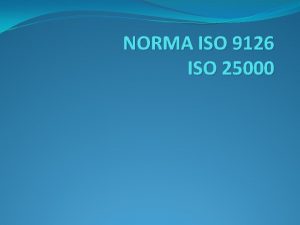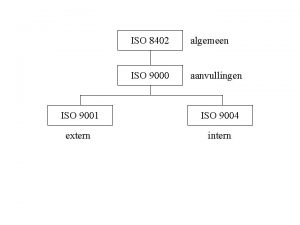THE INTERNATIONAL STANDARD ISO 2384 The International Organization

























- Slides: 25

THE INTERNATIONAL STANDARD ISO 2384

The International Organization for Standardization (ISO) is a worldwide organization which deals with the development of standardization for the presentation of services and documents in order to uniform the criteria with which they are produced in all fields. The ISO, based in Geneva, is a federation of national standards institutes, which, other than contributing to the definition of international standards, helps to develop any specific national versions.

As far as translations are concerned, Great Britain and the United States relate to 2384 ISO published in 1977, and approved by twenty-four countries. The title of this standard is «Documentation - Presentation of translations» and it essentially deals with two problems: 4 In what measure can a translation be considered a substitute to the original document 4 In what measure must it be possible to identify the original document

Clause four of this standard lists the essential and complementary (compulsory and noncompulsory) elements in translations, distinguishing four different kinds of publications: books, periodicals, articles, and patents.

& Full name of the author/s of the original text, specifying his/her/their role: whether it is an individual author or a corporate one (firm or company for example), chief editor, and scientific editor. & Title of the text which has been translated or the translation of the original title. & Kind of translation which has been made: if complete, partial or abridged (in the latter two cases it is necessary to specify exactly what has been translated and what has been omitted).

& Organization responsible for the translation, name of the translator or translators and of the chief editor, or of the scientific editor, or publisher of the translation. & Publisher, place, and date. For unpublished translations, address of persons responsible for the translation. & International Standard Book Number (ISBN); this number is attributed to every non-periodical publication and contains information on the publishing country, the publisher and the title. & Details on the exclusive copyrights of the translation.

It is on the other hand complementary to specify: & Language of the translation. & Translation of the title of the series or collection. As far as the information regarding the original document is concerned, it is essential to specify: & Title in the original language. & Place and date of publication in the original language. & Number of the edition (first, second, etc. ). & Publisher & Original language & ISBN

In the case of an intermediate translation it is essential to specify: & Title & Date and place of publication & Number of the edition & Intermediate language & ISBN number

By periodical we mean any publication, which is subject to any kind of recurrence. The essential elements of information related to the translation of a periodical are: ü Title in the language of the translation. ü Type of translation which has been made: if complete, partial or abridged (in the latter two cases it is necessary to specify what has been translated and what has been omitted). ü Organization responsible for the translation: person, company, editor or publisher.

üDate of publication and specification of the volume translated, number, part translated, and pagination. ü Publisher ü Key title (established by the ISDS, International Serials Data Systems) and the ISSN, International Standard Serial Number, the ISBN equivalent for periodicals

It is complementary to specify: ü Language of the translation ü Place and date of publication of the translation ü Information as to how to obtain the translation (identification number, date, price). As regards the original version of the document, it is on the other hand essential to specify: ü Title of the periodical in its original language. ü Date of publication, specification of the volume, issue and part translated and other bibliographical elements (if different from those in the translation). ü Language of the original document. ü After the pagination of the translation the pagination of the original document in brackets.

When a book is made up of miscellaneous texts by different authors, each text is called a «contribution» , while an «article» is a contribution which appears on a periodical. When the translation of an article is published, it is essential to point out some important elements: Full name of author/s specifying their role: whether it is an individual or corporate author (firm or company for example) chief editor, scientific editor. Translation of the title of the article. Type of translation: complete, partial or abridged (in the latter two cases it is necessary to specify which parts have been translated and which have been omitted).

Organization responsible for the translation, full name of the translator/s, of the chief editor, scientific editor or publisher of the translation. Information as to how to obtain the translation (identification number, date, price). It is on the other hand complementary to specify: Language of the translation Place and date of the translation If the translation has not been taken from periodicals, it is necessary to specify the type of document/s it has been taken from. It is necessary to specify if the translation is a preprint.

It is always essential to specify certain elements relating to the original when the translation of a contribution or an article is published: Title of the article in the original language Title of the periodical in the original language Year of publication, number of the volume, issue, part, pagination and any bibliographic details ISSN or ISBN.

Æ Type of document Æ Country of publication Æ Identification number Æ Names of the potential applicants or grantees, individuals or corporate Æ Translation of the title

There also certain other elements of the original that must be specified: Æ Title of the document; Æ Language of the original document It is complementary to specify: Æ Number, date, and country of the applicant Æ Number and date of filing (registration) Æ Number and date of publication; Æ Date of patent Æ Language of translation Æ Date of publication of the translation


RESPECTING THE STRUCTURE OF THE ORIGINAL u Paragraphs, their numbering if present, and subdivisions of the original text into clauses must be respected. u Any differences in content between the original document and the translation must be mentioned, specifying whether the differences are omissions, corrections, abridgements or additions to parts of the text, to the index or to the bibliography. NOTES AND BIBLIOGRAPHICAL REFERENCES u If the titles of the works or articles are translated, it is necessary for the title in the original language to follow in brackets. u The notes and translator's comments can be given either at the foot of the page or appended at the end of the text, accompanied by the words «Translator's Note» or a sentence to that effect in the language of the translation.

FORMULAE, EQUATIONS, SYMBOLS, UNITS ª Formulae, equations, symbols and units are preferably not translated. Any modification should be mentioned in a translator's note. ª If the units are converted, the value of the original units should be given in brackets. FIGURES, LEGENDS, TITLES of FIGURES and TABLES It is preferable to present figures and tables exactly in the same position in which they appear in the original text. If for any technical reason the figure has to be moved, a reference should be given at the appropriate place in the text. ª Titles, legends or other matter should be translated in full. ª If figures or tables are reproduced directly from the original, it is necessary to translate any text or notes that go with them.

TRANSLITERATION: à When the translation is in a different script (alphabet) from the original text, names of authors and non-translated words should be transliterated in compliance with the appropriate International standard regarding that country. à Standards for transliteration are necessary in order to create a correspondence between the signs/symbols from one language to another. NAMES and SYMBOLS of ORGANIZATIONS à When the organization has only one official name, it is possible to translate the name and put it in brackets the first time it appears in a text. à As far as bibliographical references are concerned, the names of the organizations are to be given in the original language. à The names of organizations should be given without any form of translation, unless these organizations have official names in different languages (for example The European Union or the World Health Organization).

ABBREVIATIONS 4 If abbreviations are used in the text, their equivalents in the language of the translation should be given. If there is no equivalent, the abbreviation should be fully explained at its first occurrence. TERMINOLOGY 4 In certain translations specific terminology belonging to a particular subject or profession is used. In these cases, it is necessary for the translator to choose the appropriate homologous in the language of the translation. However, if new terminology related to innovative concepts is used, it is recommended that the original term should follow the translation of such terms in brackets.

éIDENTIFICATION of AUTHORS é Honorific titles such as «Member of the Academy of Sciences» must be translated. é The expressions relative to the author's part in the preparation of a document (such as the chief editor, new edition by. . . ) must always be translated. é The identification of the professional status or qualification of an author, such as jr. for Junior, or sr. for Senior, or Prof. for Professor, must be given in the original language unless sanctioned by usage, in which case they must be translated. RETRANSLATION é In the case of a retranslation it is essential to refer to the intermediate translation and to the original publication.

GEOGRAPHICAL NAMES [ Some geographical names have versions in different languages (London, Londres, Londra, Londen, for example) while others do not have used versions: in this case they must not be translated but left in their original language. In bibliographical references, geographical names are to be given in the original language or transliterated. DATES [ The date of the original publication must be shown in the translation. If the original publication uses a different calendar (for example the Julian calendar, the Jewish calendar, the Arabic or Japanese calendars), the corresponding year in the calendar of the culture of the translation must be given.

TRANSLATION of PERIODICALS + With the exception of very few cases, most of all related to multilingual publications, the title of periodicals must be kept in their original language and not translated. The translation is possible only if authorized by the publisher. + In the translation it is also essential to show the volume, issue and corresponding parts of the original issue. The year of publication of the original must appear before the year of publication of the translation. The pagination of the translation must be followed by the pagination of the original.

NAME OF THE TRANSLATOR ò One of the essential elements in identifying a translation is by always showing the name of the translator, (in compliance with the advice given by the International Federation of Translators and Recommendation n. 5 adopted by UNESCO) unless the translation is a patent or a similar document. AUTHORITY TO PUBLISH TRANSLATIONS ò The heading of the translation should carry the reference to the original document, and a statement authorizing the publication with or without exclusive rights of the translation.
 Iso 9000 iso 9001 iso 9002 iso 9003 iso 9004
Iso 9000 iso 9001 iso 9002 iso 9003 iso 9004 Iso 2384
Iso 2384 Iso 27014:2013 is the iso 27000 series standard for
Iso 27014:2013 is the iso 27000 series standard for Casco toolbox
Casco toolbox Simbolo primer cuadrante
Simbolo primer cuadrante Iso 8583 to iso 20022 mapping
Iso 8583 to iso 20022 mapping Ohsas 18001 iso 14001 comparison
Ohsas 18001 iso 14001 comparison Iso 9000 iso 22000
Iso 9000 iso 22000 Process organization in computer organization
Process organization in computer organization Point by point organization example
Point by point organization example Reference dimension
Reference dimension Reducing scale in engineering drawing
Reducing scale in engineering drawing Iso ts 22163
Iso ts 22163 Windows embedded standard 7 iso
Windows embedded standard 7 iso Iso 10110 standard
Iso 10110 standard The iso/iec 27001 standard — dcm services
The iso/iec 27001 standard — dcm services Son logo nigeria
Son logo nigeria Standard error in the mean
Standard error in the mean Power dynamics of standard language
Power dynamics of standard language Standard costing process
Standard costing process Kerangka kurikulum standard sekolah menengah
Kerangka kurikulum standard sekolah menengah Firms that emphasize global integration make and sell
Firms that emphasize global integration make and sell International metrology organization headquarters
International metrology organization headquarters Child welfare services and agencies
Child welfare services and agencies Car bumper height
Car bumper height Designing organizations for the international environment
Designing organizations for the international environment
